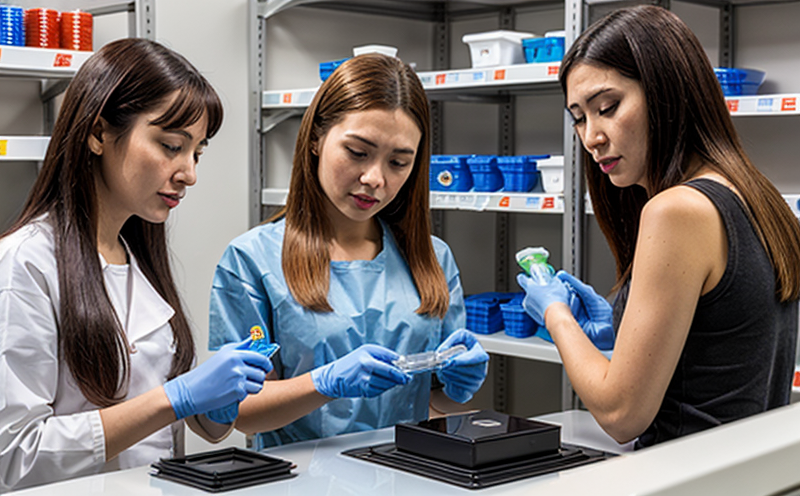DIN 50017 Climate Aging Testing of Consumer Plastics
The DIN 50017 standard is an essential component in the evaluation and certification of consumer plastics, particularly those exposed to environmental conditions that can cause degradation over time. This testing method focuses on assessing how plastic materials withstand exposure to sunlight, heat, moisture, and other climatic factors.
Consumer plastics, such as those used in household appliances, furniture, toys, and packaging, are often subjected to varying climate conditions during their lifecycle. The DIN 50017 Climate Aging Testing aims to predict the aging behavior of these materials under realistic environmental stressors. This testing is crucial for manufacturers aiming to ensure product longevity, compliance with safety regulations, and customer satisfaction.
The test involves exposing plastic specimens to controlled climatic conditions that simulate real-world exposure scenarios. These conditions typically include high temperatures (up to 60°C), humidity levels exceeding 93%, and ultraviolet radiation from artificial sunlight sources. The duration of the test can vary significantly depending on the specific requirements, but it often lasts for several weeks or months.
During testing, specimens are placed in a climate chamber where they undergo exposure to heat, moisture, and UV light according to predefined cycles. After the test period, the samples are examined visually and by other means such as tensile strength tests, impact resistance measurements, and color change assessments. These evaluations help determine whether the plastic has maintained its physical properties and appearance.
The DIN 50017 standard is widely used across various sectors including electronics, automotive, household goods, and packaging industries. It ensures that consumer plastics meet stringent quality standards before reaching market shelves. Compliance with this standard enhances product reliability, extends shelf life, and improves overall customer experience.
For R&D engineers involved in developing new materials or improving existing ones, understanding the nuances of DIN 50017 Climate Aging Testing is vital. By incorporating these tests early in the design process, they can make informed decisions about material selection and formulation adjustments to enhance performance under adverse environmental conditions.
Quality managers responsible for ensuring product quality throughout production processes will also find value in implementing this test method. They can use it as part of their quality assurance protocols to identify potential weaknesses in plastic components early on, thereby preventing costly recalls or failures after products have been released into the market.
In summary, DIN 50017 Climate Aging Testing plays a critical role in assessing consumer plastics' resistance to environmental aging factors. By providing reliable data on material durability and integrity, this testing method supports informed decision-making within manufacturing organizations.
Applied Standards
| Standard Name | Description |
|---|---|
| DIN 50017 Part 1: General Requirements | This part provides the general requirements for climate aging tests of plastics, including test methods and evaluation criteria. |
| DIN 50017 Part 2: Exposure to Sunlight | Details specific procedures for exposing specimens to artificial sunlight in order to simulate outdoor exposure. |
| DIN 50017 Part 3: Exposure to Heat and Humidity | Describes the conditions under which samples are exposed to high temperatures combined with elevated humidity levels, simulating indoor storage environments. |
The above table highlights some key parts of DIN 50017 that are directly relevant to climate aging testing. Each part contributes uniquely towards comprehensively evaluating the effects of various environmental factors on consumer plastics.
Benefits
Ensures compliance with international standards and regulations, which is essential for export markets.
Improves product longevity by identifying potential weaknesses in plastic materials early during development stages.
Maintains consistent quality levels across different batches of production runs, ensuring uniform performance.
Promotes customer satisfaction through the delivery of durable and reliable products that meet expected standards.
By incorporating DIN 50017 Climate Aging Testing into their product development cycles, manufacturers can gain several advantages. These include increased market competitiveness due to superior performance attributes; reduced risk of recalls or warranty claims resulting from premature failures; enhanced reputation among consumers who appreciate well-engineered products; and more efficient use of resources by avoiding unnecessary rework.
International Acceptance and Recognition
DIN 50017 has gained widespread recognition worldwide, particularly in Europe where it is widely accepted as a benchmark for assessing the durability of plastics used in various applications.
The standard is recognized by numerous industry associations and regulatory bodies globally, adding credibility to test results obtained through this method.
Besides its domestic relevance within Germany, DIN 50017 has been adopted internationally due to its rigorous approach towards evaluating the aging effects on plastics. Its acceptance extends beyond Europe into regions like North America, Asia-Pacific, and other parts of the world where similar climatic conditions impact plastic products.
International recognition enhances the confidence level among stakeholders involved in the supply chain, from raw material suppliers to end consumers. It also facilitates smoother trade processes by ensuring that products meet common quality benchmarks across borders.





